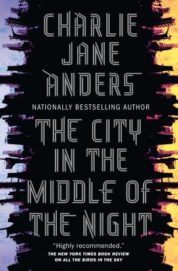 Charlie Jane Anders
Charlie Jane Anders
Tor ($26.99)
by Chris Barsanti
As far as unfair comparisons go, a blurb like “this generation’s Le Guin” on a dustjacket is pretty high up there. That doesn’t mean that a gloriously rich voice such as Charlie Jane Anders, author of 2017’s prizewinning All the Birds in the Sky, does not deserve some strong accolades. But while Anders has as grand an imagination and skill for world-building as Le Guin, the comparison establishes the wrong kind of expectations, in the same way that any director should be allowed to file a lawsuit against those who would call them “this generation’s Spielberg.”
Anders’ latest, The City in the Middle of the Night, is precisely the kind of novel that benefits from being called speculative fiction rather than science fiction, which can still seem pejorative to some readers. So far, “speculative fiction” seems not to scare off genre-unfriendly readers, meaning Anders may attract the kind of broad readership she deserves with this bristling and vivid book.
The planet of January is a splendidly imagined world of terror and beauty. Humanity seems to have ended up there out of apocalyptic necessity many centuries hence in this millennium, following the launch of a desperate last-minute Earth-escaping ark. The ride over was a rough one:
By the time the great city-states of Earth were building the Mothership to escape a ruined planet, Zagreb was in steep decline from its worldwide supremacy back at the start of the Brilliant Age. . . . the Zagreb contingent made sure to bring everything from musical instruments to cooking spices to beautiful handcrafted furniture to great works of literature—everything you’d need to re-create true civilization.
But after the radiation leaks, the explosive decompression, the Hydroponic Garden Massacre, and all the tiny wars, the Zagreb stock ended up ruined. They arrived with nothing.
With all the residual tensions left over from that bloody birthing, what’s left of humanity on January is not doing well by the time the novel opens. The planet is no paradise but an alien place in the truest sense of the word, divided between blasting sunlight and freezing dark, with two radically different cities—one chaos and the other control—barely hanging on in the day-night border region.
The city of control is called Xiosphant. Protected from the sun by massive shutters and fed by fantastical Ferris Wheel-like rotating crop contraptions termed farmwheels, it’s characterized by baroquely layered linguistic conventions, mind-numbing conformity, and a rigidly authoritarian bent that regulates every second of its citizens’ lives. Like most dictatorial regimes, total control is sold as means of survival; in a world so inhospitable to humanity, nothing can be left to chance. So the population sets their lives by a dizzyingly complex set of time conventions (“4 Wander before Blue” is one that Anders throws out without bothering to explain) and fears change.
Anders’s reluctant hero is Sophie, a college girl from the (literal) dark side of town who is infatuated with her rich, beautiful roommate Bianca, who appears to share her revolutionary views. After taking the fall for Bianca’s petty thievery and being exiled from Xiosphant for her troubles, Sophie returns to town as something of a ghost, without a place in a densely ordered society and looking for a purpose.
That’s where Mouth, another vagabond who falls in love too quickly and leaps before she looks, comes into the story. Part of a smuggler band with the phenomenal name the Resourceful Couriers, Mouth has her own infatuation—with her smuggler partner Alyssa (they pair off for survival in the horrors of the deathlands between Xiosphant and its sister city Argelo) and some foolhardy plans that will end up with Bianca and Sophie on the run. Laced into the love-amidst-danger plot is Sophie’s run-in with some of January’s original inhabitants, frightening-seeming creatures who are derisively termed “crocodiles” by the humans, but who may hold the key to everyone’s survival on a planet that seems to be getting more uninhabitable by the day.
The plotting and dialogue of The City in the Middle of the Night are somewhat haphazard, though the chaos has its own momentum—such as when the action shifts to the nightclubs and souks of the gangster-run Argelo, a place that feels like Mogadishu and the Mos Eisley spaceport crossed with Prohibition-era Chicago, or pirate battles on the Sea of Murder, whose name requires no further explanation. Anders even dashes the action with some blackly comic absurdity, including the scene in which two combatants in a knife fight have to use one hand each to hold up a metal plate to shield them from a deadly acid rain. She has a deep, impassioned attachment to her characters, writing of their desires and fears with a fierce urgency (“I would burn everything to fine ash, both cities, the world, to keep you with me”).
As a onetime editor of the website io9, Anders knows her way around the science fiction genre and then some. It is possible that imbibing so much in the field left her with a surfeit of ideas, which seem to spill out of her novel’s pages. Elements of The Dispossessed and The Left Hand of Darkness seem to flutter through this work, which also shares a lot with China Mieville’s linguistic obsessions and even Sherri Teppers’s nose for the power structures on far-off planets. But Anders remains a fiery original, a perilously rare thing in today’s remake and remix culture. For that, she must be celebrated all on her own.
